DAEWOO NUBIRA 2004 Service Repair Manual
Manufacturer: DAEWOO, Model Year: 2004, Model line: NUBIRA, Model: DAEWOO NUBIRA 2004Pages: 2643, PDF Size: 80.54 MB
Page 1901 of 2643

5C – 14ICLUTCH
DAEWOO V–121 BL4
GENERAL DESCRIPTION
AND SYSTEM OPERATION
DRIVING MEMBERS
The driving members consist of two flat surfaces ma-
chined to a smooth finish. One of these is the rear face of
the engine flywheel and the other is the pressure plate.
The pressure plate is fitted into a steel cover which is
bolted the flywheel.
DRIVEN MEMBERS
The driven member is the clutch disc with a splined hub.The splined hub is free to slide lengthwise along the
splines of the input shaft and drives the input shaft through
these same splines.
The driving and driven members are held in contact by
spring pressure. This pressure is exerted by a diaphragm
spring in the pressure plate assembly.
OPERATING MEMBERS
The clutch release system consists of the clutch pedal, the
clutch master cylinder, and concentric slave cylinder.
Unlike the former system to release the clutch by the re-
lease lever and release fork, the concentric slave cylinder
type makes the concentric slave cylinder directly perform
the clutch release by the generated pressure through the
clutch pedal operation.
Page 1902 of 2643
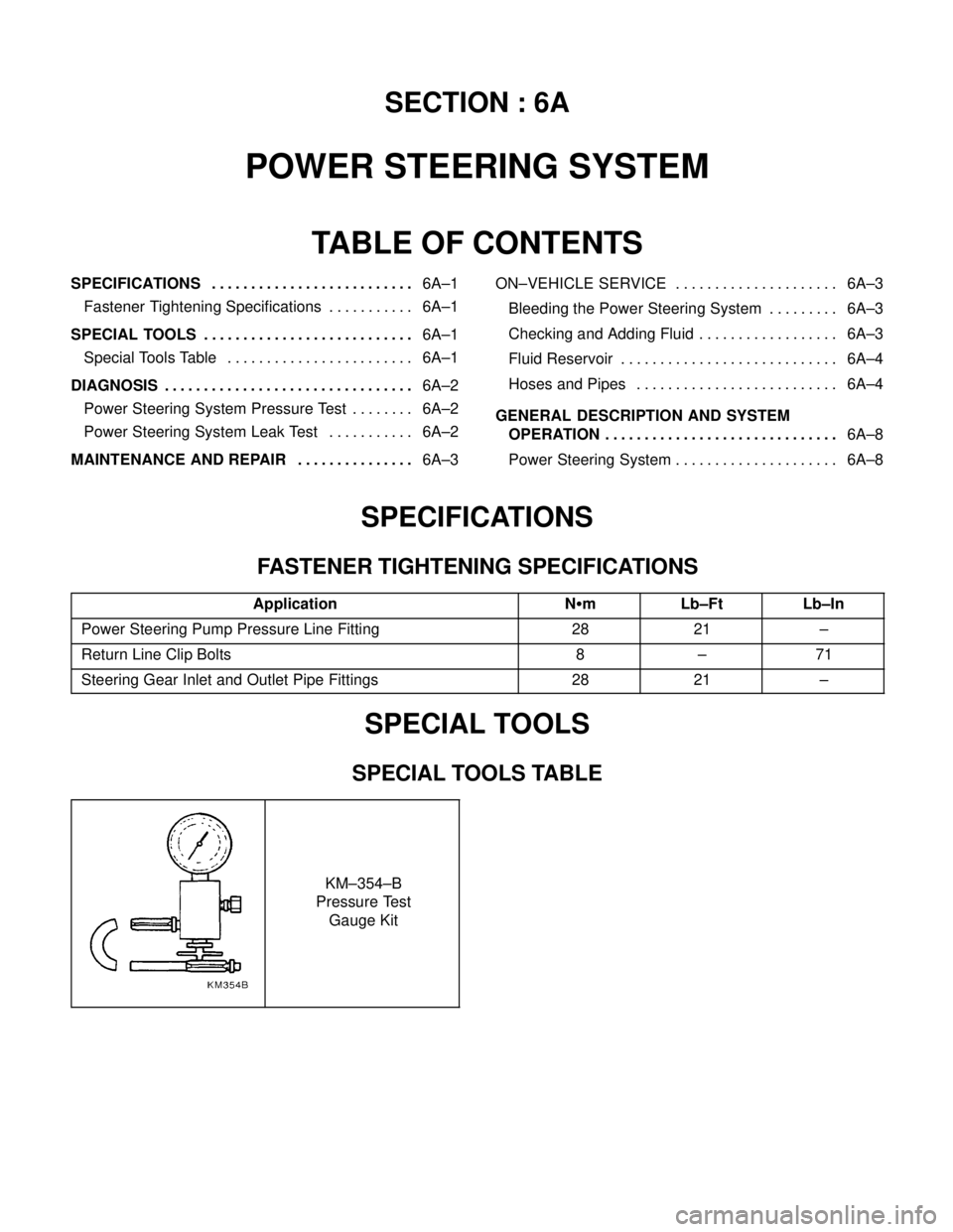
SECTION : 6A
POWER STEERING SYSTEM
TABLE OF CONTENTS
SPECIFICATIONS6A–1 . . . . . . . . . . . . . . . . . . . . . . . . . .
Fastener Tightening Specifications 6A–1. . . . . . . . . . .
SPECIAL TOOLS6A–1 . . . . . . . . . . . . . . . . . . . . . . . . . . .
Special Tools Table 6A–1. . . . . . . . . . . . . . . . . . . . . . . .
DIAGNOSIS6A–2 . . . . . . . . . . . . . . . . . . . . . . . . . . . . . . . .
Power Steering System Pressure Test 6A–2. . . . . . . .
Power Steering System Leak Test 6A–2. . . . . . . . . . .
MAINTENANCE AND REPAIR6A–3 . . . . . . . . . . . . . . . ON–VEHICLE SERVICE 6A–3. . . . . . . . . . . . . . . . . . . . .
Bleeding the Power Steering System 6A–3. . . . . . . . .
Checking and Adding Fluid 6A–3. . . . . . . . . . . . . . . . . .
Fluid Reservoir 6A–4. . . . . . . . . . . . . . . . . . . . . . . . . . . .
Hoses and Pipes 6A–4. . . . . . . . . . . . . . . . . . . . . . . . . .
GENERAL DESCRIPTION AND SYSTEM
OPERATION6A–8 . . . . . . . . . . . . . . . . . . . . . . . . . . . . . .
Power Steering System 6A–8. . . . . . . . . . . . . . . . . . . . .
SPECIFICATIONS
FASTENER TIGHTENING SPECIFICATIONS
ApplicationNSmLb–FtLb–In
Power Steering Pump Pressure Line Fitting2821–
Return Line Clip Bolts8–71
Steering Gear Inlet and Outlet Pipe Fittings2821–
SPECIAL TOOLS
SPECIAL TOOLS TABLE
KM–354–B
Pressure Test
Gauge Kit
Page 1903 of 2643

6A – 2IPOWER STEERING SYSTEM
DAEWOO V–121 BL4
DIAGNOSIS
POWER STEERING SYSTEM
PRESSURE TEST
Tools Required
KM–354–B Pressure Test Gauge Kit
Check the fluid pressure as follows to determine whether
the trouble is in the pump or the gear unit.
Test Procedure
1. Check the power steering fluid level and the power
steering pump belt tension. Refer to ”Checking and
Adding Fluid” in this section and Section 6B, Power
Steering Pump.
2. Disconnect the high pressure line at the pump. Use
a small container to catch any fluid.
3. Connect the hose of the pressure test gauge kit
KM–354–B to the power steering pressure hose
from the power steering pump.
4. Place the gear selector lever in PARK (automatic
transaxle–equipped vehicles) or NEUTRAL (manual
transaxle–equipped vehicles). Set the parking
brake.
5. Open the gauge valve fully.
6. Start the engine and let it idle.
7. Turn the steering wheel from lock to lock several
times to warm the fluid to operating temperature.
8. Increase the engine speed to 1,500 rpm.
Notice : The power steering pump could be damaged if
the valve is fully closed for more than 5 seconds.
9. Close the gauge valve fully, and read the pressure.
The pump pressure with the valve closed should be
between 8,330 kPa to 8,820 kPa (1,208 psi to
1,279 psi). With electronic variable orifice, the pres-
sure should be between 8,500 kPa to 8,960 kPa
(1,233 psi to 1,299 psi).
10. Immediately open the gauge valve fully.
11. Turn the steering wheel all the way to the left and
the right. If the pressure is within the specified lim-
its, the problem is not in the pump. Check the pow-
er steering gear for leaks.
POWER STEERING SYSTEM LEAK
TEST
General Procedure
Inspect the following:
S The fluid reservoir for overfill.
S Fluid for aeration and overflow.
S The hoses for loose connections.
S The torsion bar, stub shaft and adjuster seals for
leaks.
S The component sealing surfaces for damage.
Important : Verify the exact point of the leak. The point
from which the fluid is dripping is not necessarily the point
at which the system is leaking. When service is required,
clean the leak area upon disassembly, replace the leaking
seal, check the component sealing surfaces for damage
and reset the torque bolt to specifications, where required.
External Leak Check
The purpose of this procedure is to pinpoint the location of
the leak. In some cases, the leak can be easily located, but
seepage–type leaks may be harder to find. To locate seep-
age leaks, use the following method:
1. With the engine off, wipe dry the complete power
steering system.
2. Check the power steering fluid level in the pump’s
reservoir. Adjust the fluid level as necessary. Refer
to ”Checking and Adding Fluid” in this section.
Notice : Do not hold the steering wheel at a stop for any
length of time as this can damage the power steering
pump.
3. Start the engine. Turn the steering wheel counter-
clockwise and clockwise from stop to stop several
times.
4. Find the exact area of the leak and repair it.
Page 1904 of 2643

POWER STEERING SYSTEM 6A – 3
DAEWOO V–121 BL4
MAINTENANCE AND REPAIR
ON–VEHICLE SERVICE
BLEEDING THE POWER STEERING
SYSTEM
If the power steering hydraulic system has been serviced,
an accurate fluid level reading cannot be obtained until the
air is bled from the system. Follow these steps to bleed the
air from the system.
1. Turn the wheels all the way to the left and add the
power steering fluid to the MIN mark on the fluid
level indicator.
Notice : When adding fluid or making a complete fluid
change, always use DEXRON®–II or III power steering
fluid. Failure to use the proper fluid will cause hose and
seal damage and fluid leaks.
2. Start the engine. With the engine running at fast
idle, recheck the fluid level. If necessary, add fluid
to bring the level up to the MIN mark.
3. Bleed the system by turning the wheels from side to
side without reaching the stop at either end. Keep
the fluid level at the MIN mark. The air must be
eliminated from the fluid before normal steering ac-
tion can be obtained.
4. Return the wheels to the center position. Continue
running the engine for 2 to 3 minutes.
5. Road test the car to be sure the steering functions
normally and is free from noise.
6. Recheck the fluid level as described in steps 1 and
2. Make sure the fluid level is at the MAX mark af-
ter the system has stabilized at its normal operating
temperature. Add fluid as needed.
CHECKING AND ADDING FLUID
Notice : When adding fluid or making a complete fluid
change, always use DEXRON®–II or III power steering
fluid. Failure to use the proper fluid will cause hose and
seal damage and fluid leaks.
1. The power steering fluid level is indicated either by
marks on a see–through fluid reservoir or by marks
on a fluid level indicator on the fluid reservoir cap.
2. If the fluid is warmed up to 66°C (150°F), the fluid
level should be between the MAX and MIN marks.
Add fluid as needed.
3. If the fluid is cool, 21°C (70°F), the fluid level
should be at the MIN mark. Add fluid as needed.
Page 1905 of 2643
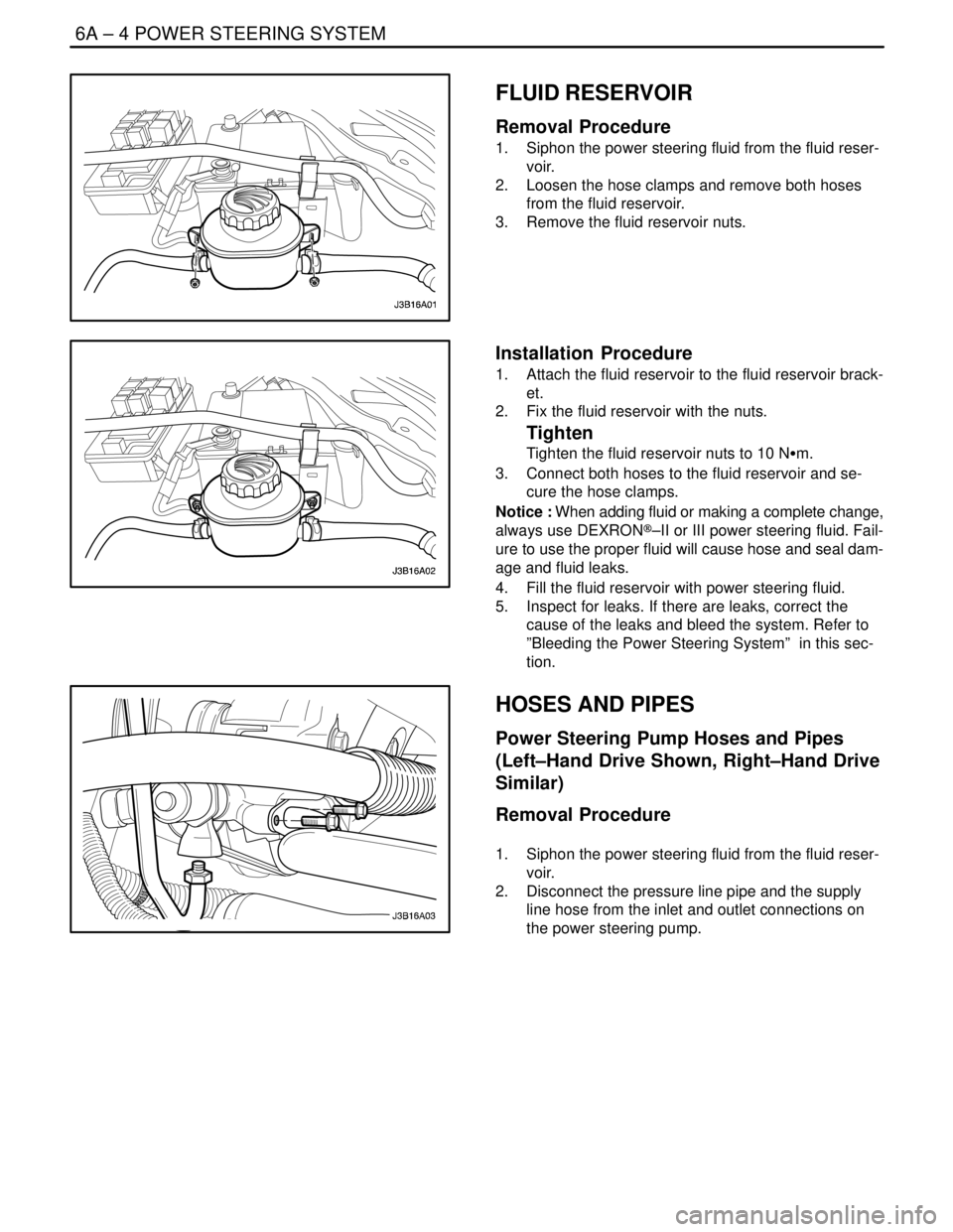
6A – 4IPOWER STEERING SYSTEM
DAEWOO V–121 BL4
FLUID RESERVOIR
Removal Procedure
1. Siphon the power steering fluid from the fluid reser-
voir.
2. Loosen the hose clamps and remove both hoses
from the fluid reservoir.
3. Remove the fluid reservoir nuts.
Installation Procedure
1. Attach the fluid reservoir to the fluid reservoir brack-
et.
2. Fix the fluid reservoir with the nuts.
Tighten
Tighten the fluid reservoir nuts to 10 NSm.
3. Connect both hoses to the fluid reservoir and se-
cure the hose clamps.
Notice : When adding fluid or making a complete change,
always use DEXRON®–II or III power steering fluid. Fail-
ure to use the proper fluid will cause hose and seal dam-
age and fluid leaks.
4. Fill the fluid reservoir with power steering fluid.
5. Inspect for leaks. If there are leaks, correct the
cause of the leaks and bleed the system. Refer to
”Bleeding the Power Steering System” in this sec-
tion.
HOSES AND PIPES
Power Steering Pump Hoses and Pipes
(Left–Hand Drive Shown, Right–Hand Drive
Similar)
Removal Procedure
1. Siphon the power steering fluid from the fluid reser-
voir.
2. Disconnect the pressure line pipe and the supply
line hose from the inlet and outlet connections on
the power steering pump.
Page 1906 of 2643
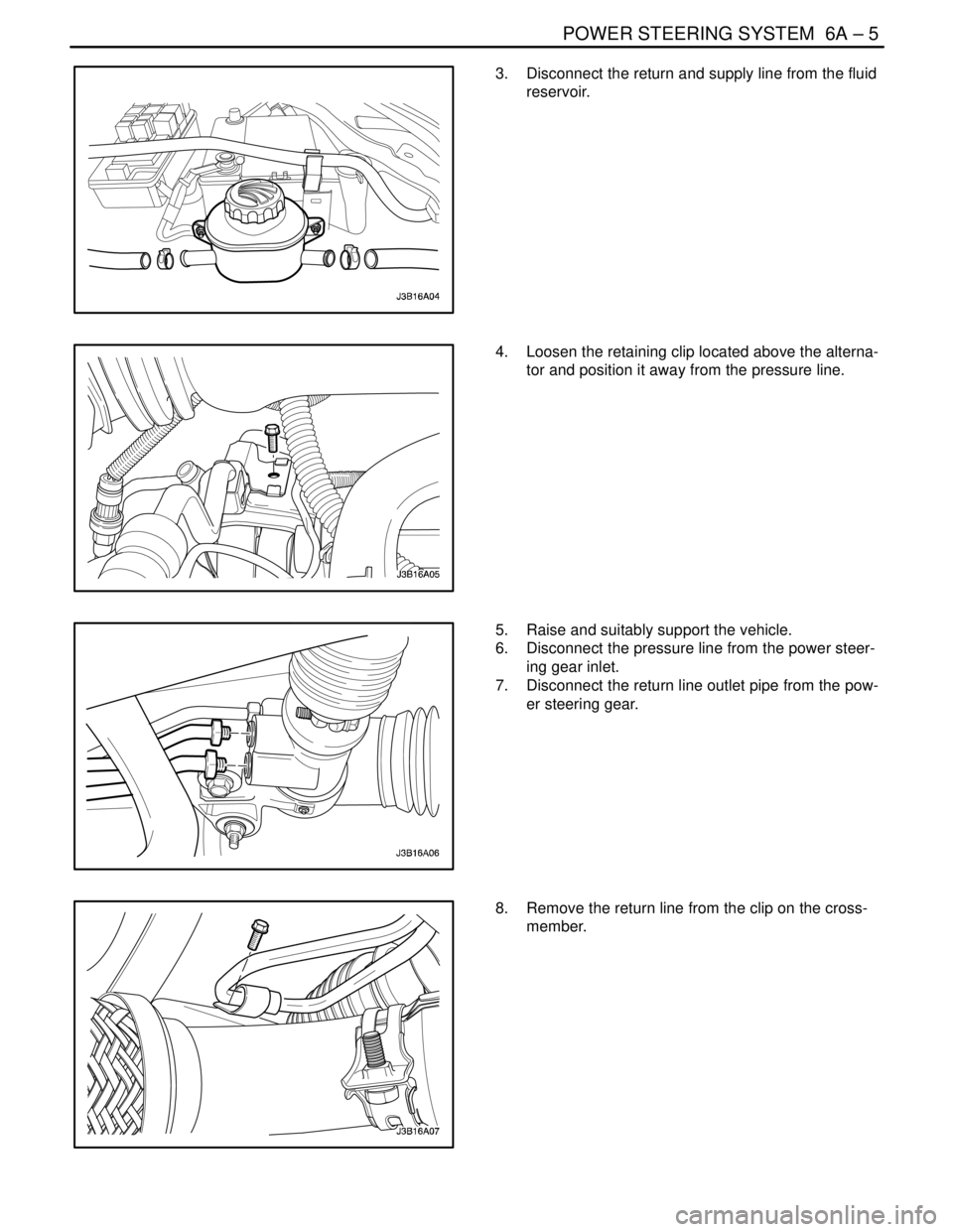
POWER STEERING SYSTEM 6A – 5
DAEWOO V–121 BL4
3. Disconnect the return and supply line from the fluid
reservoir.
4. Loosen the retaining clip located above the alterna-
tor and position it away from the pressure line.
5. Raise and suitably support the vehicle.
6. Disconnect the pressure line from the power steer-
ing gear inlet.
7. Disconnect the return line outlet pipe from the pow-
er steering gear.
8. Remove the return line from the clip on the cross-
member.
Page 1907 of 2643
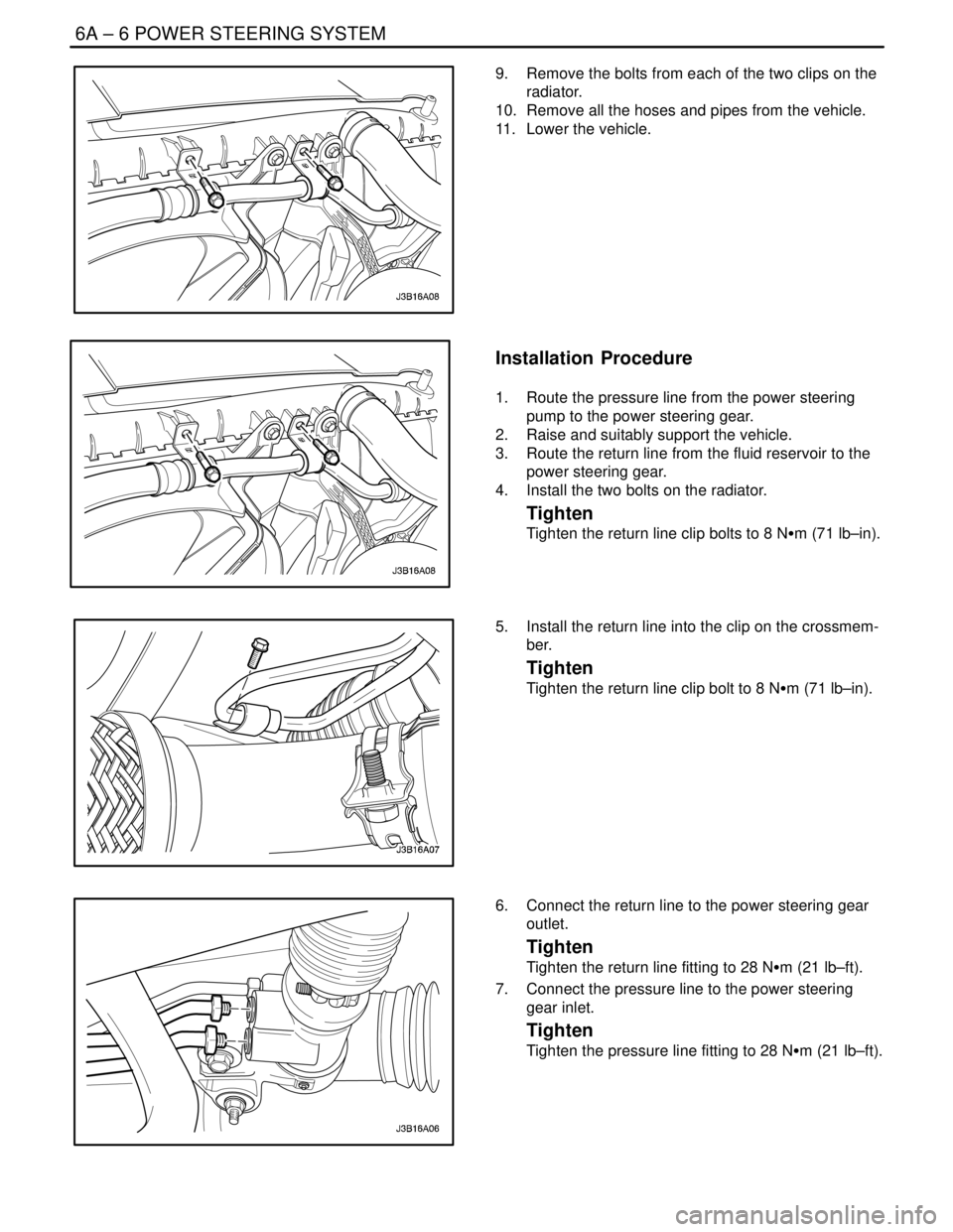
6A – 6IPOWER STEERING SYSTEM
DAEWOO V–121 BL4
9. Remove the bolts from each of the two clips on the
radiator.
10. Remove all the hoses and pipes from the vehicle.
11. Lower the vehicle.
Installation Procedure
1. Route the pressure line from the power steering
pump to the power steering gear.
2. Raise and suitably support the vehicle.
3. Route the return line from the fluid reservoir to the
power steering gear.
4. Install the two bolts on the radiator.
Tighten
Tighten the return line clip bolts to 8 NSm (71 lb–in).
5. Install the return line into the clip on the crossmem-
ber.
Tighten
Tighten the return line clip bolt to 8 NSm (71 lb–in).
6. Connect the return line to the power steering gear
outlet.
Tighten
Tighten the return line fitting to 28 NSm (21 lb–ft).
7. Connect the pressure line to the power steering
gear inlet.
Tighten
Tighten the pressure line fitting to 28 NSm (21 lb–ft).
Page 1908 of 2643
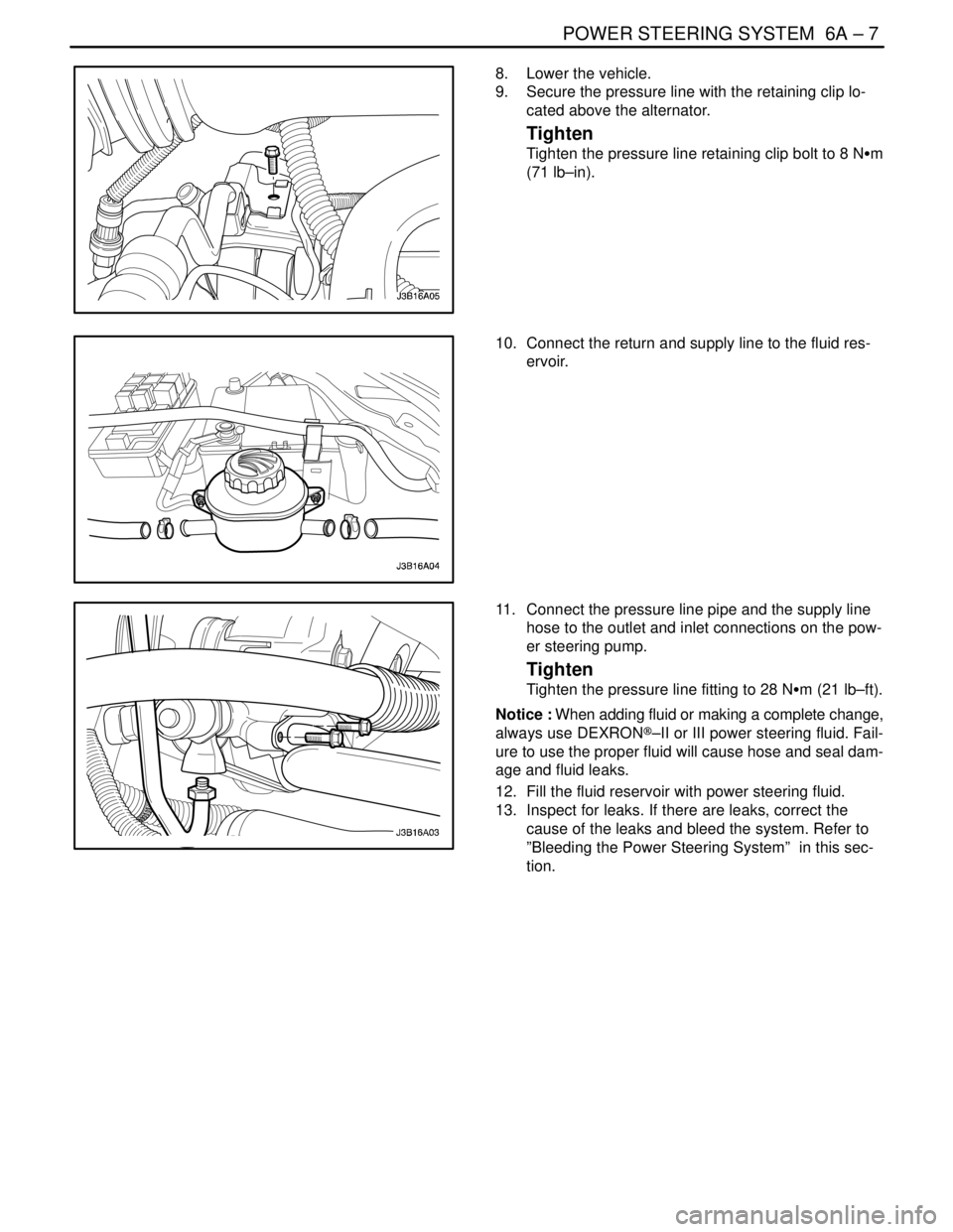
POWER STEERING SYSTEM 6A – 7
DAEWOO V–121 BL4
8. Lower the vehicle.
9. Secure the pressure line with the retaining clip lo-
cated above the alternator.
Tighten
Tighten the pressure line retaining clip bolt to 8 NSm
(71 lb–in).
10. Connect the return and supply line to the fluid res-
ervoir.
11. Connect the pressure line pipe and the supply line
hose to the outlet and inlet connections on the pow-
er steering pump.
Tighten
Tighten the pressure line fitting to 28 NSm (21 lb–ft).
Notice : When adding fluid or making a complete change,
always use DEXRON®–II or III power steering fluid. Fail-
ure to use the proper fluid will cause hose and seal dam-
age and fluid leaks.
12. Fill the fluid reservoir with power steering fluid.
13. Inspect for leaks. If there are leaks, correct the
cause of the leaks and bleed the system. Refer to
”Bleeding the Power Steering System” in this sec-
tion.
Page 1909 of 2643

6A – 8IPOWER STEERING SYSTEM
DAEWOO V–121 BL4
GENERAL DESCRIPTION
AND SYSTEM OPERATION
POWER STEERING SYSTEM
General Description
The power steering system consists of three components:
the power steering pump, the power steering fluid reser-
voir and the the power steering rack and pinion gear. The
power steering pump is a vane–type pump providing hy-
draulic pressure for the system and is powered by the en-gine. It draws on the power steering fluid reservoir, which
in turn is connected to the power steering gear. A pres-
sure–relief valve inside the flow control valve limits the
pump pressure. The power steering rack and pinion gear
has a rotary control valve which directs hydraulic fluid
coming from the power steering pump to one side or the
other side of the rack piston. The integral rack piston is at-
tached to the rack. The rack piston converts hydraulic
pressure to a linear force which moves the rack to the left
or the right. The force is then transmitted through the inner
and the outer tie rods to the steering knuckles, which turn
the wheels.
Page 1910 of 2643

SECTION : 6B
POWER STEERING PUMP
TABLE OF CONTENTS
SPECIFICATIONS6B–1 . . . . . . . . . . . . . . . . . . . . . . . . . .
General Specifications 6B–1. . . . . . . . . . . . . . . . . . . . .
Fastener Tightening Specifications 6B–1. . . . . . . . . . .
DIAGNOSIS6B–2 . . . . . . . . . . . . . . . . . . . . . . . . . . . . . . . .
Power Steering Pump Diagnosis 6B–2. . . . . . . . . . . . .
MAINTENANCE AND REPAIR6B–3 . . . . . . . . . . . . . . .
ON–VEHICLE SERVICE 6B–3. . . . . . . . . . . . . . . . . . . . . Serpentine Accessory Drive Belt 6B–3. . . . . . . . . . . . .
Pump Assembly 6B–4. . . . . . . . . . . . . . . . . . . . . . . . . . .
UNIT REPAIR 6B–7. . . . . . . . . . . . . . . . . . . . . . . . . . . . . .
Pump 6B–7. . . . . . . . . . . . . . . . . . . . . . . . . . . . . . . . . . . .
GENERAL DESCRIPTION AND SYSTEM
OPERATION6B–8 . . . . . . . . . . . . . . . . . . . . . . . . . . . . . .
Power Steering Pump 6B–8. . . . . . . . . . . . . . . . . . . . . .
SPECIFICATIONS
GENERAL SPECIFICATIONS
ApplicationDescription
LubricantPower Steering Fluid DEXRON®–II or III
Pressure
– without EVO8330 kPa ~ 8820 kPa (1208 psi ~ 1279 psi)
– with EVO8500 kPa ~ 8960 kPa (1233 psi ~ 1299 psi)
FASTENER TIGHTENING SPECIFICATIONS
ApplicationNSmLb–FtLb–In
Air Filter Housing Assembly Bolts6–53
High–Pressure Hose Fitting2821–
Power Steering Pump Bolts2518–
Right Side Power Steering Pump Bracket Bolts3526–